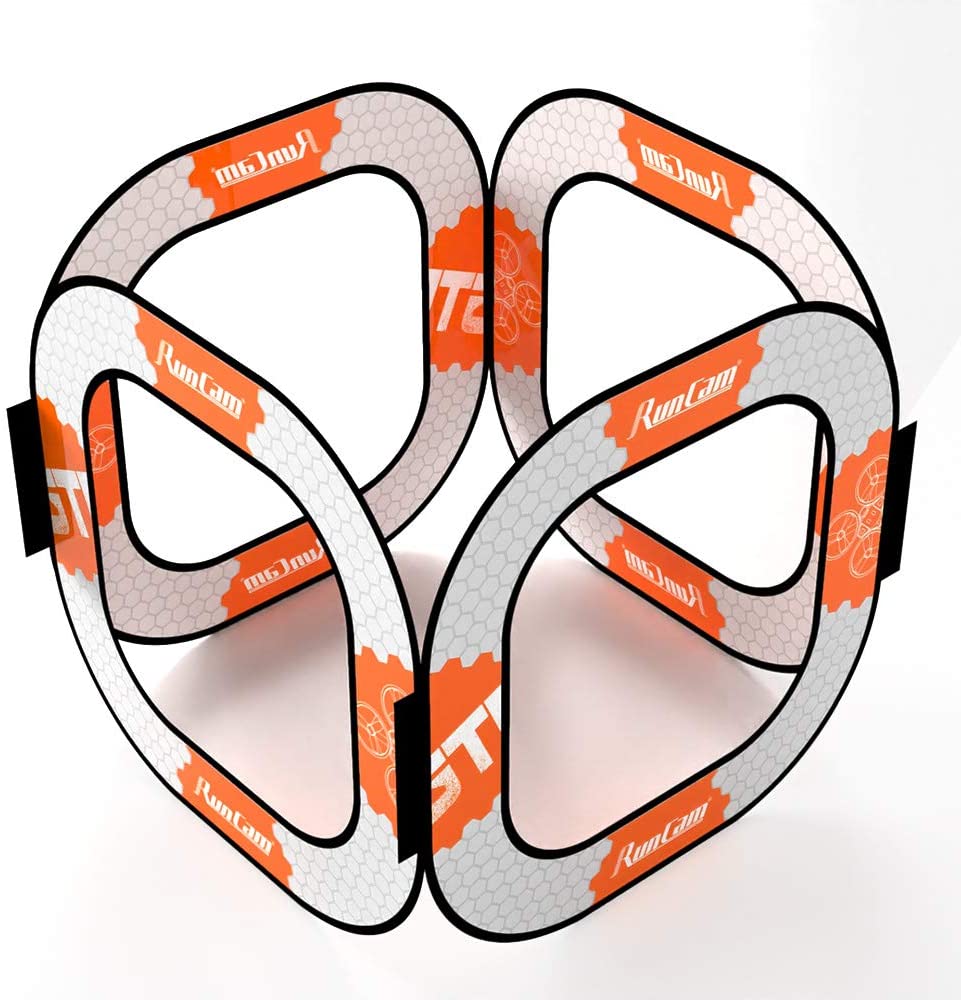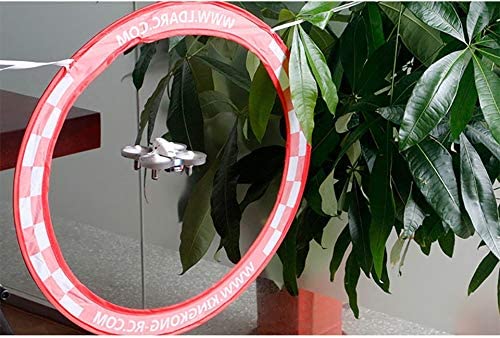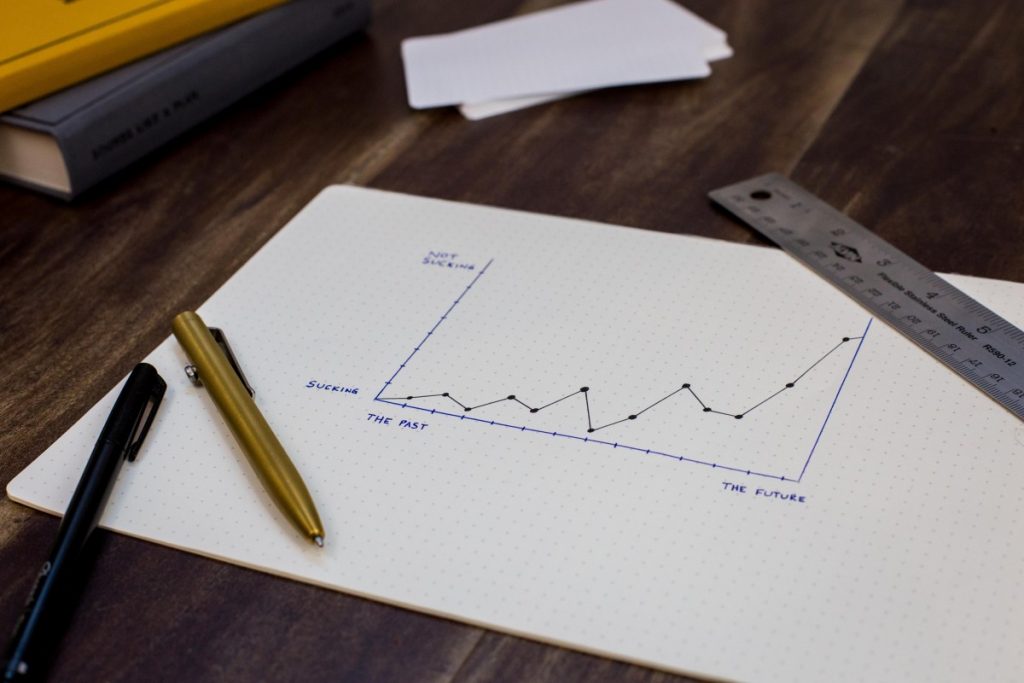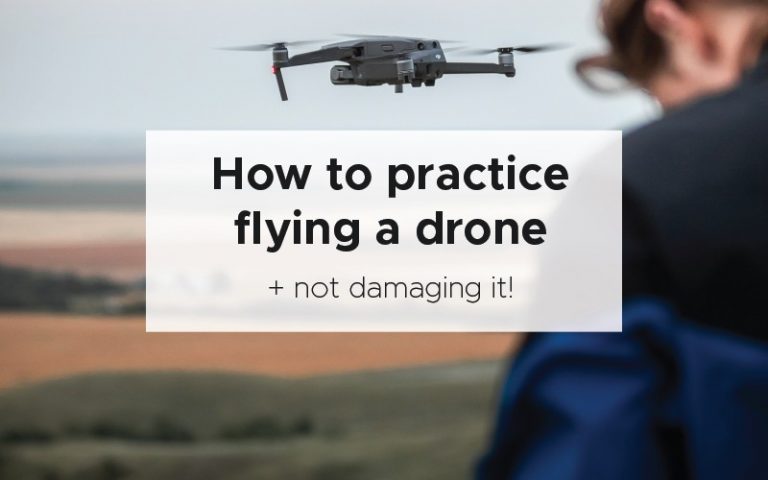There is one thing that separates are excellent drone flyers from good ones and that is practice. Practising flying your drone is one of the things that will guarantee that you will become an effective and efficient drone pilot. Make no mistake, however, getting good at anything requires putting in effort in the right way for the right amount of time until you get to the level of skill that you want. Importantly, you must enjoy the process as well. Enjoying the process means that you are more likely to go out and push through the tough challenges so that you can get better. In this article we are going to talk about how to practice flying drone and how to do it in a way where you won’t risk smashing up one of your most expensive gadgets.
Practising flying a drone requires that you break down the skills that you want to learn into manageable bite-size chunks. You should then head out to a wide open space, get some practice gates, and slowly build your skills. Consistency over time will be the thing that sets your practice out and turns you into an expert drone flyer.
Let’s have a look at some of the important aspects of how to practice flying a drone and it all starts with breaking down the skills that you want to improve into bite-size manageable chunks.
Break down the skills
Getting better at any skill requires persistence and patience. However, getting better at flying a drone means different things to different people. You need to be honest with yourself and ask: what is it that I actually want to get better at. Here are some examples of the things that you can practice as a drone pilot:
- taking photos and video – you may want to get better at using your drone as a tool to capture photos and videos.
- Precision flying – precision flying in between buildings is great for things like real estate photography and impressive reveal shots through trees.
- Racing – racing your drone is a skill which requires you to practice flying at high speed with high accuracy. One of the more difficult skills to learn.
- Becoming creative – the great thing about a drone is that it increases your creative freedom almost exponentially as a photographer. You may want to use the drone to become more creative as a creative professional.
No matter what skill you want to build you must break it down into smaller manageable chunks.
Break it down into manageable chunks
This could look like emulating one of your favourite drone pilots. It could look like writing down 10 sub- skills under a broad heading that you want to get better at. Or it could look like narrowing into a single type of drone flying and practising that single skill in till you get better.
Now one model of practising will fit everyone so take the time to understand what it is about drone that you want to get better at. Then, list out all of the skills and sub- skills and go through them one at a time. It can be overwhelming to look at a professional drone pilot and try to emulate them immediately whereas any skill is actually the mastery of a smaller set of sub- skills that combine to give you the broader skill.
Work out the order to learn the skills
Once you have worked out the sub skills make a list of the most sensible order to tackle them in. For example for drone racing this could be doing certain manoeuvres over and over again such as a figure of eight, a left turn, a right turn, maintaining altitude along a racing straight, and much more.
Check out my other article – how to improve drone skills – eight simple steps – click here.
Once you have listed out all of the skills and the order in which you need to practice them then you need to go out and practice them. For most skills you can make use of practice gates so that you are able to practice precision flying, use the gates to measure distances, and other uses.
Get some practice gates
Racing gates are a fantastic addition to any drone accessory bag if you are serious about practising to get better. There are a range of racing gates currently on the market from simple circles that you fly through to cubes that you can stack on top of each other for advanced slalom courses.
Here are some of the best drone race gates that you can purchase from Amazon:
RunCam FPV Racing Gates

- FPV Racing Air Gate from RunCam is the ultimate tool for cool racing and provides an interesting obstacle to fly through
- Small size gate perfect for micro-sized drones like 3 inches and below 3 inches micro quads
- It is made from reinforced tricot fabric, high tensile and extra solid fiberglass poles supported, more durable
- No assembly required, Pop-up design, just take out of carrying bag and unfold to open. Once done, simply twist/fold and put back into a flat round carry bag
- FPV square gate is light and easy to be assembled, you can enjoy Drone Racing in any place & any time!
LDARC practice gates

- Portable, Foldable Landing Pad for RC Drone.
- Packing Apron:250mm
- Arch:500mm
- 250mm Packing Apron, it suitable for take-off and landing (Tiny GT7/GT8,Tiny R7,Tiny 6X/7X/8X,Tiny 6/7,ET Series,FPVEGG,TELLO and so on)
- Suitable for Practicing Outdoor
Race gates can be used in a variety of ways such as:
- As a start and finish line to time your races.
- As obstacles to go through, around, under, or over.
- As a figure of eight centrepoint for a slalom.
- Place them horizontally to practice precision ascent and decent.
- And much more – you can use these drone racing gates in a variety of creative ways you are only limited by your imagination.
The thing about drone racing gates is that they can be fun on their own but they also give you an objective position from which to measure time. One of the best ways to get better when practising flying a drone is to measure what you actually want to improve.
What gets measured gets improved
There is a simple saying in the business world which is:
that which gets measured gets optimised

I learnt this while growing a start-up over the last two years and now I am witnessing the results of this as I am starting to run more often. When I first started to run I did not measure anything and just wanted to cover a certain distance. I did not measure time nor my average kilometres in a given time. I was starting to lose motivation when I realised that I was able to use an app to measure the stats from my run. Ever since that moment I have been optimising for my pace, distance, average speed, consistency, and everything has improved.
If you’re serious about getting better flying a drone I recommend that you measure at least one metric for each sub- skill that you are trying to learn. That will give you the ability to see if you are actually getting better (people tend to be very bad at being objective) and also give you the ability to track your progress over time. Nothing is more motivating than seeing an upwards or downwards trending line.
Practice in large open areas
If you are learning how to fly a drone it is common for beginners to want to head to a big field such as a cricket oval or large recreational field. However, as we get more confident in our drone flying abilities we tend to not go to large open areas as often.
I recommend that if you are serious about practising your drone you should head to large open areas regularly which will allow you to turn off sensors and safety features and learn to fly the drone in a more man your and potentially dangerous way. This will give you the ability to comfortably expand your zone of capability so that when you are in a less forgiving environment you are confident in your skills as you have practiced them in a large open space.
Ask for some advice from a professional
There is one thing that a lot of people are bad at doing and that is asking for help. Sure, you can go out and practice all of the drone skills yourself. You can even use resources like YouTube and online courses to direct your learning. But there is one thing guaranteed to improve your drone to ability quicker – and that is to seek advice from a professional drone pilot.
There are a few places where you can find information and help from pilots that have been through it all. Many universities and adult education institutions are now offering short courses so that you can become accredited in your country. Even if you do not require to become accredited for flying a drone in your country it is still a very good idea to invest the time and money into learning from a professional. It will catalyse your improvement and stop you from making silly mistakes that so many of us make and are too stubborn to realise.
If you are interested in an online course here are some examples of drone schools and courses that may interest you:
- Drone U – drone new offers some of the widest range of drone training courses from beginner courses all the way up to advanced training. This is a subscription model and they currently charge a $470 per year membership or you can pay $47 per month. This gets you a private Facebook community, access to all online training courses, as well as a bunch of other resources.
- Drone launch Academy – this is an online course that is based primarily on video content. It primarily has content about part 107 and the cause can be purchased for $149.
- Drone pilot ground school – this company has trained 25,000+ solo pilots and enterprise drone pilot teams. Depending on how many people in your team need to get their part 107 certification the cost varies from $299 for one person up to $192 per person for groups of 10 to 24 people.
- Drone training on Udemy – If you’re looking for specific drone skills a really well received course is drone training: 50 drills to improve your flying skills. In this course you will learn about 50 drills in order to fly your drone with more precision and dexterity. The great thing is that it’s only about US$10 on sale. It has 3.5 hours of OnDemand video, two downloadable resources, and full lifetime access as well as a certificate of completion once you are done.
There is no excuse to not at least consider getting help from professional – some of these courses are incredibly cost-effective and I have seen first hand the results of investing in my skill acquisition from a professional.
Use a flight simulator
Sometimes, you just can’t get out of the house to practice flying your drone. And that is absolutely okay. Life gets in the way of a load of things including the best laid down plans to practice your drone flying skills.
It could be the weather, it could be personal and men, whatever it is you can use a drone flight simulator to practice your drone skills. The good thing about this approach is that you can be really boisterous and daring because nothing will get damaged if you crash a virtual drone. Unlike in real life where many hundreds of dollars (if not thousands of dollars) could be lost with a simple lapse in concentration.
Here are the top flight simulators that you can buy (the DJI simulator even has a free option).
- DJI Drone simulator – Free, Enterprise, and Energy versions available. It has different training modules that support nearly every drone that they have manufactured.
- DroneSimPro – $29.99 for Mac and Windows.
- Real Flight RF8 – $188 for windows
- Phoenix R/C – $139 for windows
The great thing about the DJI drone simulator is that your remote control for your drone plugs into your computer via the USB port and it is exactly like controlling your DJI drone in real life.
Practice the built-in shots manually
Most of the commercial camera drones now available have a range of automated shots. This includes stuff like dronie shots, boomerang shots, asteroid shots, circle, helix, and much more. There’s a reason these have been preprogramed into your drone.
They are the most effective shots that everyone wants to get.
What I like to do is practice these built-in shots manually. What that means is that I first of all run the automated shot and then I try to reproduce the exact movement of the drone and camera manually. This is easier said than done but I have found that after a little bit of practice for each shot I can normally pull off a good version of it.
The reason I think it is really important to practice these sorts of shots is that they are the basics of capturing awesome drone shots. I like to consider it like a guitarist practising solos. Even though it seems spontaneous when they are performing it is actually a series of unique licks and phrases they have already practised. By having the built-in shots down manually these are the shots you can pull from your toolkit at any time and because you can do the manually you can combine them in any order.
Spend at least 2 hours flying your drone each week
One thing that makes you better at flying a drone is consistency. At a bare minimum you should aim to do to one hour flying sessions each week where you practice the skills that you have identified at the beginning of this article. There is not one skill that cannot be improved with sheer time doing it.
Have a look at your current schedule and work out to see if you can fit two hours flying your drone into each week. It doesn’t have to be particularly fancy or a good location other than allowing you to fully practice the skills you want to develop. It can be as simple as your back garden (if your local jurisdiction allows) or it can be somewhere more interesting like the beach and a park with interesting trees.
This is not about trying to do as much practice as possible in a short amount of time, this is about consistency. Don’t try to be a hero in the first few weeks of owning a drone because it is not sustainable. It is much better to learn skills over a longer period of time slower than it is to try to fit them all in and rush the process of learning. You can capitalise on your interest early on by getting the foundation flying skills out of the way and comfortably in your wheelhouse.
SLOWLY expand your capability
It is important that you slowly expand your capability as a drone pilot. You need to get rid of any ego, bravado, or delusions of grandeur when practising flying your drone. If you do not you will quite easily crash or damage your drone within the first few practice sessions.
Always practice within your capability and gently push the boundaries of what you are able to do. If you are uncomfortable with a certain skill you can always try again another day – some days I just not meant for pushing the boundaries.
Slow and steady wins the race every time.
Learn all of the rules for your country
The country in which you intend to fly your drone dictate essentially how much fun you can have after buying a drone. Some laws and countries have drone regulations that make it incredibly hard to fly your drone freely. Before buying a drone. You should check that you don’t have to get advanced training, expensive licenses, or register your drone.
Here are links to a few different countries regulations in terms of drones and where you can and cannot fly.
Drone flying restriction in USA
- https://uavcoach.com/drone-laws-in-united-states-of-america/#:~:text=You%20must%20be%20in%20a,Administration%20(TSA)%20security%20screening.
- https://www.faa.gov/uas/
- https://dronedj.com/2020/05/13/usa-drone-laws-faq/
Drone flying restriction in Canada
- https://tc.canada.ca/en/aviation/drone-safety/flying-your-drone-safely-legally
- https://www.cbc.ca/doczone/m_features/drone-laws-canada
Drone flying restriction in Australia
- https://uavcoach.com/drone-laws-in-australia/
- https://www.casa.gov.au/knowyourdrone/drone-rules
- https://www.casa.gov.au/drones/rules/sub2kg
- https://dronedj.com/2020/05/18/australia-drone-laws-faq/
Drone flying restriction in UK
- https://www.nottinghamshire.police.uk/advice/drone-law-uk
- https://uavcoach.com/drone-laws-in-united-kingdom/
If you’re not sure about the rules and regulations in your country of origin, then get in contact with the organisation that controls the airspace. They will be able to guide you in the best things to do and consider for buying a drone.
I quite often use the drone flying app open sky. Open sky gives me the ability to see where I can and cannot fly relative to my location. I recommend that if you are going to practice flying a drone that you download an app which will tell you whether or not you are flying legally.
There is nothing more frustrating than flying and getting some time in when you are interrupted by someone telling you that you cannot fly in a certain area. You need to be confident when you’re telling that person that you are legally allowed to fly there without causing more of an argument or telling a lie.
Practice until it is second nature
The last tip that I would give you is to practice until it is second nature. Manipulating a drone in 3D space can be very confusing. You have a range of movements and joystick options and combinations. You need to practice in till the drone does what you wanted to do almost instinctively.
Things like pitch, yaw, thrust, roll, and attitude are all combined in a range of different ways. The problem with this is that it can get very confusing very quickly.
One of the best things that I was ever told is
Don’t practice until you get it right but practice into you can’t get it wrong
Practising until you cannot get it wrong will give you a level of confidence above and beyond other drone flyers and also give you the confidence that you can fly your drone safely and predictably every time.




